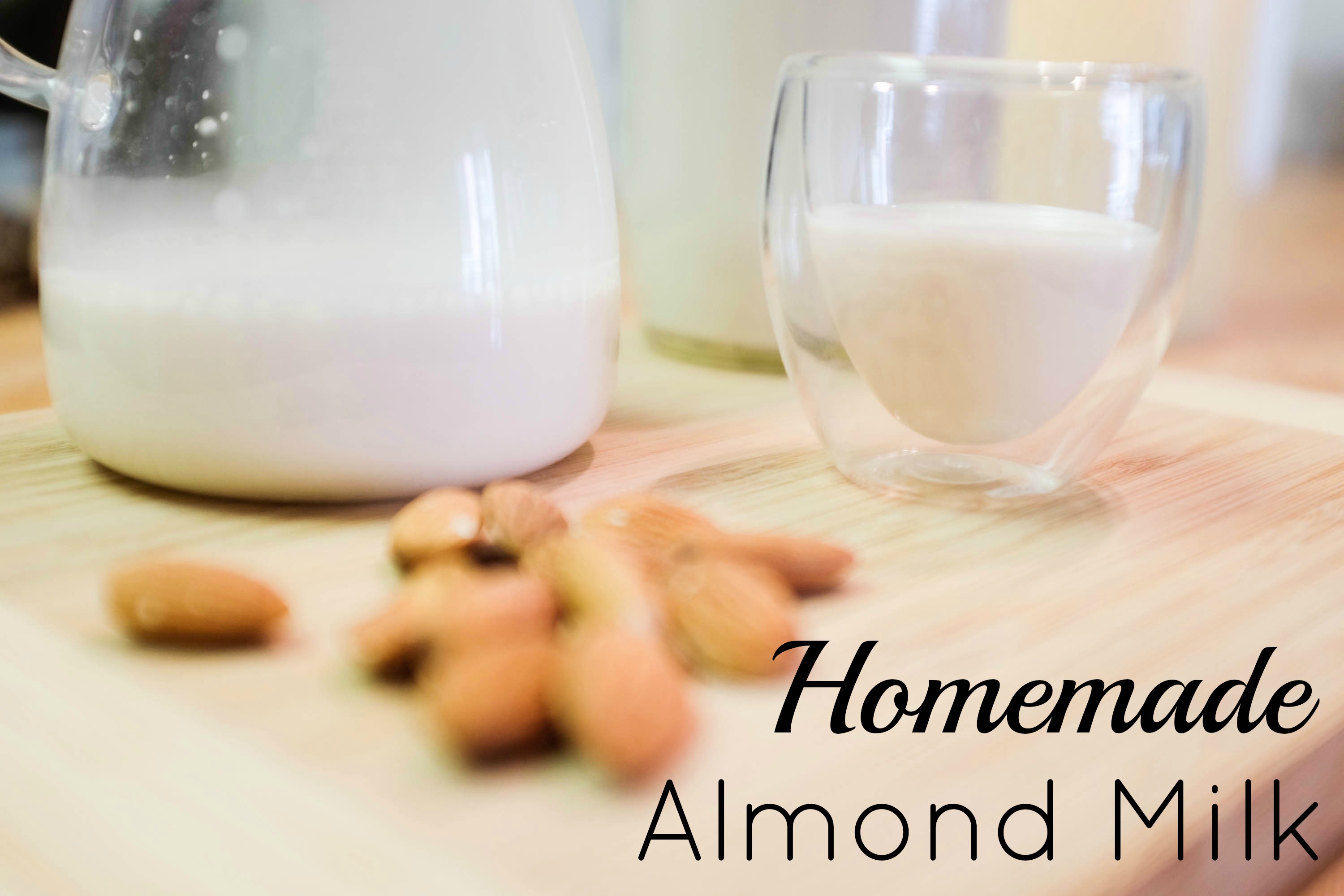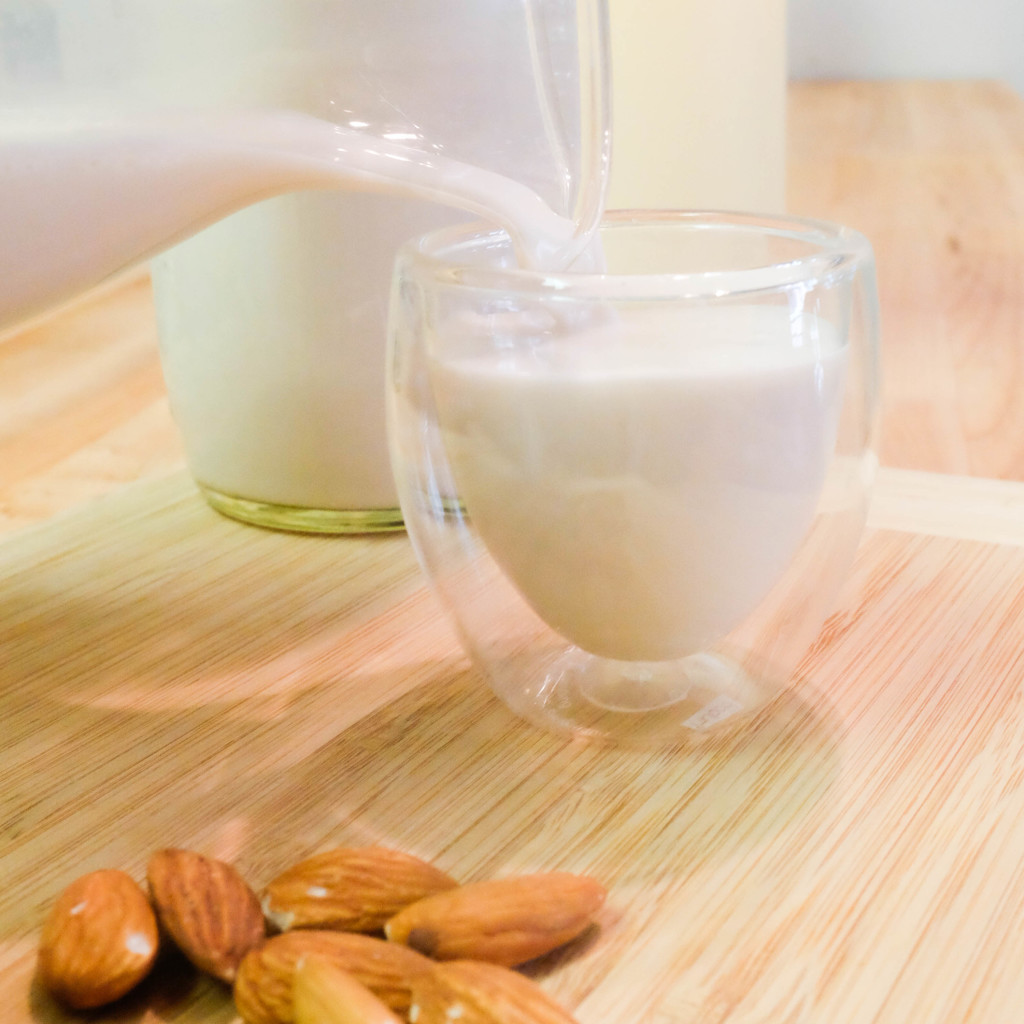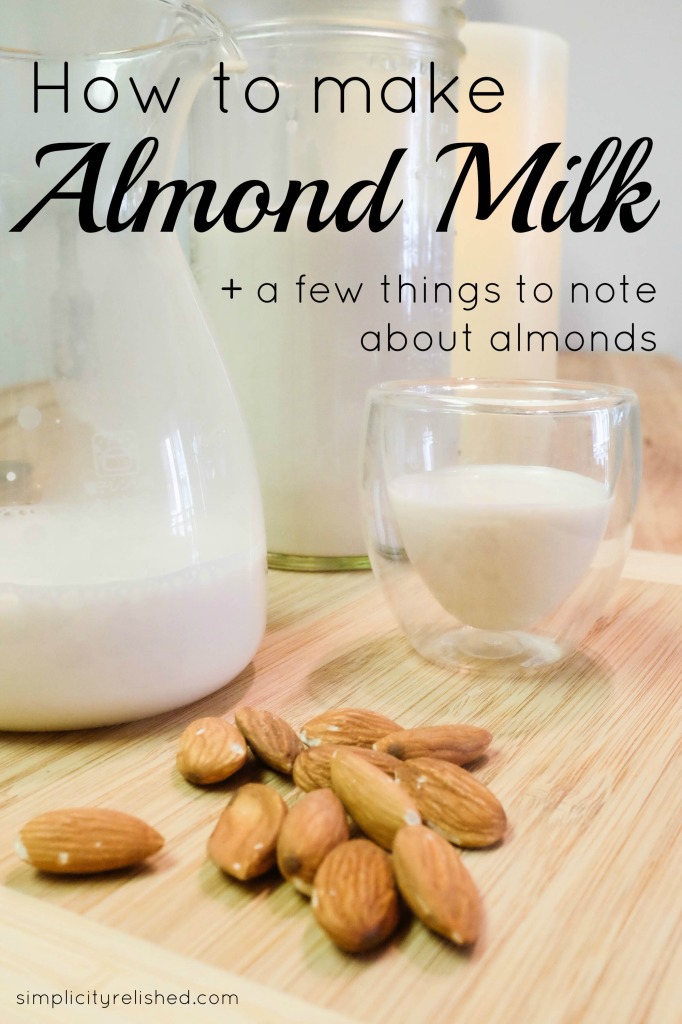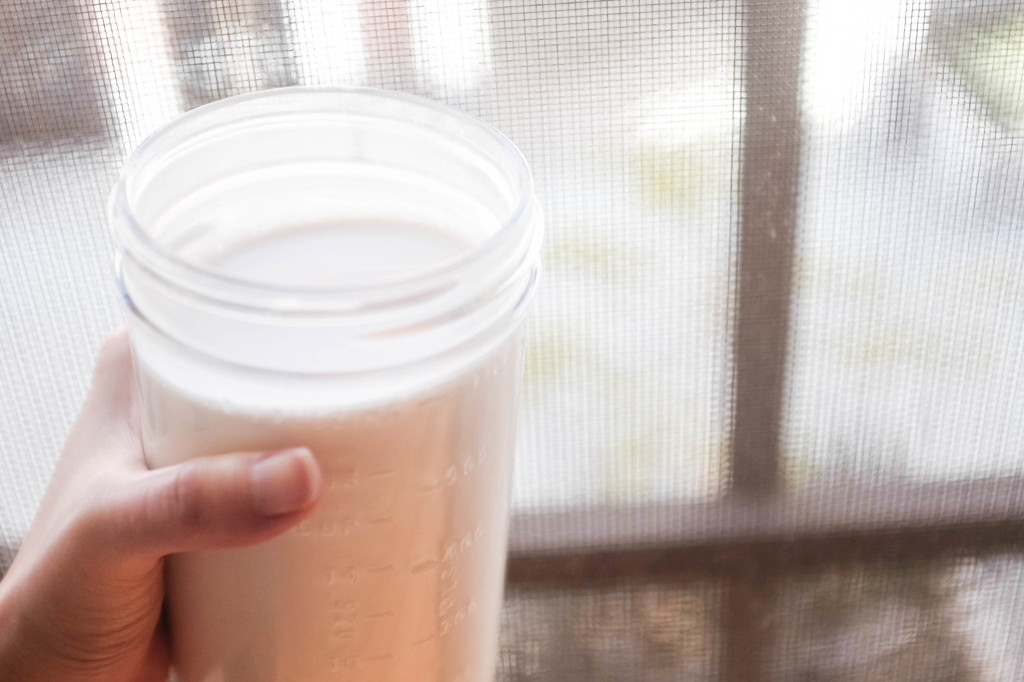When I was little, I used to think that milk should be on tap. I drank about as much milk as I did water– and who could blame me, I was a 90’s kid! Calcium was so trendy.
Nowadays, though I drink it less than I used to, I still drink milk. And as it turns out, Whole Foods’ 365 Organic brand is actually organic, humane, and totally affordable (source). We buy a whole gallon of it practically every week.
But I digress.
What about almond milk? It’s super popular among people who can’t or prefer not to consume dairy, and it’s often used as a nutritional and culinary substitute. But what is almond milk? What’s the story behind it?
A little chat about almonds…
As it turns out, almost everything that might concern you about regular milk is probably also a concern about almond milk (with the exception of lactose, of course). Almonds grown in the US have to undergo a pasteurization process, which is sometimes done with heat, and other times with chemicals. In other words, you cannot purchase truly raw almonds in the US, at least not since 2007. And more often than not, they’ve been treated with a chemical before they were harvested and/or after. (If inhumane farming is your concern, then think of the pollution and runoffs from almond farms.) Read more about US almonds here.
So, if you’ve thought about avoiding dairy for health reasons (as I have in the past), it turns out the almond milk might be an imperfect solution. Furthermore, store-bought almond milk is full of stabilizers and preservatives; unsurprising, as real almond milk will only last about 2 days chilled.
So what’s an almond-milk lover to do? LET’S MAKE OUR OWN ALMOND MILK!
And the result? Creamy, nourishing, fresh, sweet, delicious. What’s not to love?
How to make real almond milk
What you need:
- 1 cup almonds, preferably raw, organic, and imported (like these)
- 1-2 cups of water to blend with almonds, depending on taste
- Cheesecloth and mesh strainer, plus a large bowl
- Sturdy blender
- Glass jars for storage
Instructions:
In a bowl, soak the almonds overnight in tap water. This will soften them and also make them expand in size. They should soak at least overnight, and can soak for even longer. Do not skip this step!!
Drain the soaked almonds and place them in your blender. Add 1-2 cups of water. Less water means thicker milk; more water is thinner. 2 cups water yields about the same consistency as nonfat milk.
Pulse the almonds in the blender to break them down, and then run the blender for about 2 minutes, or until everything is broken down to a pulp.
Place the mesh strainer over a large bowl, and place the cheesecloth inside it. Carefully pour the almond milk into the cheesecloth, stopping when you can still wrap the cheesecloth around the moist mashed almonds.
As the milk drains through, wrap up the cheesecloth and give it a good squeeze to get all the milk out. Dump the remaining almond meal, or save it for some other use (such as adding to breads or oatmeal). Repeat until you’ve strained all the almond milk.
Pour the milk into glass jars and chill immediately. Drink the almond milk within 2 days— that is, if you can resist drinking it all at once.





Wonderful post, thank you for sharing! I need to check out that Whole Foods milk next time I’m there. When I want a low-carb or dairy-free version I often make coconut milk, maybe I’ll share my recipe soon. I love the flavor and creaminess it has.
Awesome!! So, I have a Vitamix. I know that they’re not within range for a lot of people (we got ours from our wedding) but they’re really great. Otherwise, try making it with small amounts of almonds first and always always soak the almonds– it softens them a lot. Make sure you pulse the blender a few times before running it, that will help break down the almonds too. Good luck!
Thanks Kelly!!
OMG! I just recently decided to try making my own. But I didn’t know all that stuff about store bought, so now I definitely will get on that!
ps. what blender do you have? I only have a ninja bullet, will that work do you think?
Thank you Daisy! I will definitely give this a read! (:
Awesome!! And yes, lots of store-bought milk is just not that good for you, it’s so processed. Have you ever looked into drinking raw milk? It is super nutritious and super clean. Here’s an article from a mom I trust who feeds raw milk to her family. Check it out! http://livesimply.me/2013/06/14/whats-the-big-deal-with-raw-milk/
I’ve gotta try it. I am lactose, and when the Dr. gives us the ok, Penelope will be switching as well. Too much “stuff” in milk. Even some organic brands are sketchy. I’ll let you know once I try. (:
This sounds great, I will have to try it out!
xx Kelly
Sparkles and Shoes
Yeah!! It’s more work, but much much better for you without all the additives!
Yes so good!! Hope you’ve had a great weekend, Rachel.
I never knew you could make your own almond milk! My best friend drinks almond milk, so I’ll definitely share this with her!
I adore almond milk! Thanks for this tutorial, I’ll see if they have raw almonds in my local health food store 🙂 Have a lovely week hun
Rachel xx
http://www.thedailyluxe.net
Awesome! Hope you love it 🙂
Dairy is so amazing, especially if your body can handle it (like mine!). I think you’ll love almond milk too, it has a super clean taste and goes well with so many things. Also, it’s good for making citrus smoothies because it won’t curdle!
I know right!! Haha there is so much marketing at the grocery store these days. Have a great weekend Erin!
Oh that’s great!! I’m pretty sure almond milk is totally paleo-friendly if you ever wanna give it a shot! It’s just almonds and water 🙂
You’re exactly right. I enjoy doing all the research and making everything we eat from scratch, but it’s a huge undertaking and not everyone has that time or interest.
Hahah yes it’s very unfortunate… I was frustrated to see that US almonds really aren’t very good for you, and that almond milk itself has so many preservatives and stabilizers! Make sure you read this article: http://www.thekitchn.com/why-i-stopped-drinking-almond-milk-started-drinking-regular-milk-again-197085
I know that I’m probably sounding super nutrition-preachy but it’s something worth noting! I’m not really sure that there are great store-bought alternatives for non-dairy drinkers. 🙁 Perhaps coconut milk?
Ah this is great for people who are lactose intolerant! And it really is so so so much better than processed almond milk from the store. 🙂
It’s so so good. And to answer your question– it is worth it, if you love almond milk. Definitely something for people who regularly buy processed pre-made almond milk, since it really is not very good for you… the almonds themselves are bad, and the additives are bad too. But, if you’ve gotten away without milk of any kind, then there’s no need! As long as you’re getting that calcium from somewhere!
Hahaha yay!! Have a lovely weekend 🙂
Yes!!! I was just saying the other day I wanted to try and make my own almond milk, I am going to follow your instructions! Thanks for sharing.
Brooke
pumps and push-ups
Wow this is very cool. I love almonds – but I have actually never tried almond milk. I am a huge fan of dairy (like a few gallons of milk/week)… If I do have sometime on my hands, I will try to make some almond milk and see how I like it!!
– Deniz
http://www.dressedupdeniz.com
WOW. What a shocker. I worry so much about the organic and fresh foods that are “apparently” clean and healthy…the almond milk is a bit surprising.I wonder what else is bad for us that is said to be “healthy!” Ahhhh! Tell us more!
xo Erin
http://www.winkandatwirl.com
I have officially ended my relationship with dairy, being on the paleo diet for over a month now. I feel good but I have never really enjoyed milk. This however if I want a bowl of cereal or cold one at night before bed after my diet, looks delicious! You always have the best recipes!
XO Chelsea http://www.shesaidhesaidfashion.com
I never liked milk as a child, but I enjoyed dairy very much. I’ve essentially cut dairy out of my life and only use almond/coconut/soy milk sparingly as a treat in my latte or in a smoothie. The food industry is all a little crazy and often makes me angry that it’s become about education and money – – it shouldn’t be this difficult to feed a family.
Thanks for sharing the recipe!
Oh my gosh! I had no idea that almond milk had as many problems as normal cow’s milk. Darn it. And I thought I was being healthier 😛 Still, I’ll continue to use almond milk because I like the taste better and it has fewer calories . . . and it doesn’t make my stomach hurt. I would make it myself, except I’m not sure I’d be able to afford it — particularly because it only lasts two days.
dance a real
Who knew it was that easy?! And would probably be way cheaper. I’m the only one that cant do milk in the household. It goes bad quickly. Thanks for this fantastic share Daisy! (:
http://www.accordingtokiki123.blogspot.com
Okay, I really need to make this. For someone who doesn’t drink milk, I’ve never made my own non-dairy milk before. WHaa?! Now my question is: is it worth the time, effort, & price to create your own almond milk?
:] // ▲ itsCarmen.com ▲
Love this tutorial! And I laughed out loud when you said milk was trendy in the 90’s — it’s so true and I can relate! 🙂
Have a good day Daisy!
Always, Anita
Thanks Annie! Do it!!! It’s so good, and I’d love to read your take on it 🙂
Thanks Gina! Yeah, I was really bummed when I found out about US almonds. 🙁 If you do make your own, I promise you’ll become addicted in no time. It’s amazing!
It’s so good! Thanks for reading, Chelsea!
Thanks Jenna! It’s really good (and tastes surprisingly different from “almond breeze”, haha)
Yeah… I was really upset when I found out about US almonds! And yes, it’s pretty easy even though it’s less convenient and more pricey than the store-bought variety. Enjoy! 🙂
Glad to hear it, thanks!! 🙂 Actually, it turns out that 365 Organic is much much better than Horizon. Horizon has a good reputation, but their practices are (according to researchers) not as good! Not sure how the prices compare, but I think the Whole Foods brand wins out with this one. 🙂 Also, I hope you enjoy making your own– it’s more work, but so much better for you.
Thank your for this! I have been dying to make my own Almond Milk and this post just inspired me to do so! You may even see a similar post on my blog one day 🙂
xo Annie
laircake.com
This post was so informative! I didn’t know about the pasteurization process for U.S. almonds. That’s so crazy that they are usually not fully raw. Makes me so sad! I do love almond milk, but I’ve been purchasing it from the store every so often. Making your own does sound like an easy and fun idea, though! Thanks so much for sharing! 🙂
Homemade almond milk is the best!
Mmmm, almond milk is so good! I need to try making at home. Thanks for the recipe!
I had no clue about all the preservatives and environmental concerns when it came to store bought almond milk! Though I probably don’t have the time or money to use this recipe regularly, I’ll definitely be incorporating it into my life! Looks easy and much, much healthier. I also love that we can used the “used” almonds for cakes/breads so nothing goes to waste. Thanks Daisy!
thesundaywardrobe.blogspot.com
Very eye opening! I enjoy drinking almond milk and I also use it to make smoothies and other blended beverages. Didn’t know about the processing part. I guess from now on I will be making my own. I also drink regular milk especially in the mornings in my coffee. I buy the Horizon Organic brand but it is kind of pricey. I have never tried the 365 brand but will get a half gallon next time I visit whole foods. Very informative post Daisy. I really enjoyed it. Thanks for sharing:-) Jeannette
http://www.msjeannieandhercloset.com